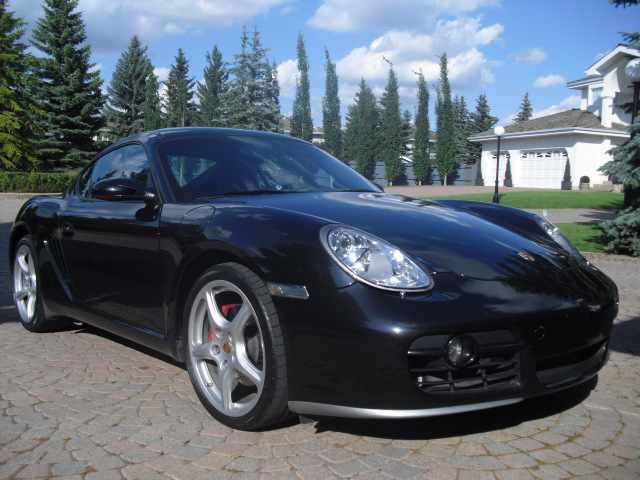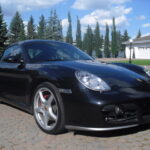by CarEnvy.ca
Let’s get the ball rolling by saying that this is the best sports car I’ve ever driven. Full stop. It’s our new benchmark and we have our good friend Ryan to thank. That’s not to say that Porsche’s mid-engine coupe is perfect, but perfection doesn’t truly exist anyways. There could never be a car that was perfect for everyone, or even just for me. My imagination and optimism will always push me to expect more from cars and the industry that produces them. That’s just the nature of the affliction that has landed me here, writing for you.
But a sports car is a special breed that rests on hallowed ground in the car enthusiast universe. We don’t expect it to do the practical stuff particularly well – but instead ask, nay demand, that it engage us in the driving process and unfurl us from our mortal coils, turning us into driving deities. It’s not just for getting from Point A to Point B, it’s the journey, and all that. The most common approach to this (uniquely First World) problem is the front-engine rear-drive approach. This is the tack taken by the Nissan 350Z that has a permanently reserved space in the underground bunker we use as the CarEnvy Garage. In our 350Z, the engine is in front of the driver and its 290-odd horsepower is sent to the rear wheels. The center of gravity is therefore further towards the nose of the vehicle, lending a more tail-happy handling character. Thankfully for us, the 350Z is very progressive and easily controlled once the rear breaks loose, making for gleaming smiles for the driver and horrified shrieks for the girlfriend in the passenger seat.
Another approach is the so-called Hot Hatch. These front-engine front-wheel drive cars include the segment-defining VW GTI, Mazdaspeed3, and the upcoming and eagerly anticipated Focus ST. This group doesn’t eschew the practicality of other sports cars, drives the wrong (safer? more winter-friendly?) wheels, and therefore appeals to pragmatists looking to add fun to their commute. These might be able to lap your local track just as fast, or even faster, than a “sports car”, but they’re not purpose built for fun, merely adapted to be so. This inevitable compromise means that Hot Hatches can never fully satisfy the driver with its depth of ability. Instead, they provide cheap(er) and cheerful motoring, and more fun more of the time. Hardly the end of the world, truly, but nor can you really develop a relationship with one as a result. Hot Hatches might be fun to date for a year or two, but you can only marry a sports car because only the best sports cars will have you regularly questioning and assessing your relationship with it and with yourself. This is the essence of the sports car experience.
Sports cars, then, are defined by their singularity of purpose and the tightness of the bond formed with their driver. The Porsche 911, unique in its rear-engine rear-drive layout, has fascinated enthusiasts for 60 years. The distinctive way in which the rear-engine placement dominates the driving experience requires years to develop a bond with as you gingerly, and even carelessly, explore its limits and your own. Take a corner too quickly and the flat-six engine could play crack-the-whip with the rest of the car, you included, leaving you to watch the corner you’ve just flown off of as you hit the barriers backwards. Talk about character! It’s no wonder that the 911 has become the icon that it is, and why we fully expect it to continue do so for years to come.
Porsche’s entry-level coupe, the Cayman takes an entirely different approach to rapid progress: the mid-engine placement. This leaves the engine and driven wheels squarely behind the driver. With the driver and passenger in the middle, the whole vehicle is closer to a 50-50 weight distribution between front and back. This is considered to be preferable on a track or on winding roads because neither the front nor the rear of the vehicle will be as likely to push or slide about, resulting in more corner grip, increased confidence, and greater corner exit speed. Or so the theory goes. With only 45 minutes behind the wheel of my good friend’s babied Porsche, I was about to find out first-hand what makes driving a modern Porsche (as opposed to the air-cooled old school) so special AND what makes driving a mid-engine car so special.
Nestling into the low-slung driver’s seat in my friend Ryan’s garage (an honourable extension of the CarEnvy Garage if ever there was one; a Sand White 2011 Cayenne Turbo sits inches away), I adjust the steering wheel higher up and closer to my chest. I notice that the thickly bolstered seat has amazing lower back support as I drop it down as far as it’ll go. It’s a snug fit in the driver’s seat. Good thing I’ve trimmed down 40lbs this year with a killer combination of running and yoga or I’d be pouring over the edges of the narrow seat. Even with the fantastic seats and the steering wheel moved up and towards me, the overall seating position doesn’t quite provide enough room for more than a quarter turn of lock to be applied before my long-limbed 6’1” frame halts further progress. The steering wheel’s not inconsiderable size might have something to do with this. The rim is thin and lends an air of delicacy to the Porsche, but you’ll never confuse the wheel for that of a Formula car – it’s more Addition Elle in circumference.
I adjust the mirrors a bit, take a look around, realize how much glass there is in the shockingly airy cabin, and finally focus myself on the task at hand: Driving the shit out of this thing. The key is entrusted into my hand and I immediately hunt for the ignition to the right of the steering column. It doesn’t take more than 1/10th of a second for me to remember that Porsche still does the Le Mans running start homage thing with the ignition to the left of the steering column (on LHD cars, at least). The 3.4L water-cooled flat-six spins into life, echoing off the walls of the garage with a noticeable snarl. I like.
After carefully reversing out of the garage and onto the street, I’m off. The first gearshift from 1st to 2nd is surprisingly short. Really, my arm was ready to move a lot more and to use more effort doing so, but the gate just sort of appeared on its own. The gear lever is a little too far back to be ideally ergonomic for driving, it requires more elbow bending than I’d like, but its placement is necessary to provide access to the hundreds of carefully strewn black buttons on the centre console. Perhaps if the steering wheel was able to extend further and I could move my seat back a bit, this wouldn’t have been an issue.
Second gear around three grand and the sharpness of the throttle response is immediately apparent. Every millimeter of size 12 shoe travel corresponds to a coldly calculated number of revs. It’s not a big number of revs either, probably about 12. Purely coincidental? I don’t believe in coincidences. Especially not when the precision of all the controls, from the light clutch to the slackless steering, is so far, far from accidental.
Two minutes later I find an open stretch and give it the full can of beans in 2nd and 3rd. My God, this thing is actually alive. As in breathing, speaking, reacting, consciously alive. And I don’t even think I touched the 7000 rpm redline in either gear. And there are 3 more gears yet. Jesus.
I find some more highway and reach absurd speeds in just 3rd gear. I start to play with the tractability and refinement of the engine, holding a gear from 2000-7000 rpm, only to find it positively peerless. This is one hell of an engine.
The ride is also beautifully controlled. The low-pro tires transmit a fair bit of sound into the cabin over frost heaves and the like, but the jarring sensation is never really transmitted into the driver’s seat or wheel. Best to keep the Bose sound system cranked and just fly into the night. So that’s what we did.
Ryan asks if I want to make a quick jump over to Groat Road. We’re currently over in the deep south side at this point, with Groat Road being in the city centre, but how could I refuse his ever-so-polite offer? Once we weave our way through Friday night traffic to Groat, the only windy road anywhere around town, I unleash a furry of deep braking, precise steering, and lateral g-forces. Not that I’m a professional driver, but this car flatters like no other. You think, it does. The mid-engine balance really comes into its own in the curves. Even during a mid-corner break in the pavement, the whole car sort of side-steps as one piece, with neither front nor rear end trying to overpower the driving experience. The car felt like a solidly forged unit, as if the parts were working like a team and the driver was the head coach. The speeds I was able to carry up and down the 1.5km stretch of urban heaven was a good 20% more than I’ve ever been able to carry in anything else, such was the confidence instilled in me by the Cayman S. After the more aggressive uphill run, I was absolutely tingling. I could especially feel it in my hands, as if little fireworks were going off in my fingertips. My body was doing its damndest to thank me. All I could say was don’t thank me, thank Ryan.
I can finally see what all the mid-engine noise is about. It’s about balance, confidence, and flattering the driver. For all its amazing potential, far more than I could hope to extract, the Cayman S made me feel as if I was closer to the limit than I realistically was. It’s the new benchmark. And it’s only a reliable engine, a better sounding exhaust, and a grippier set of tires away from perfection. If there really is such a thing.
Thanks to Ryan for 45 minutes of pure enlightenment and for reminding me of the meaning of the words “friendship” and “trust”. A hell of a car deserves a hell of a guy, and they’ve found each other here.






























